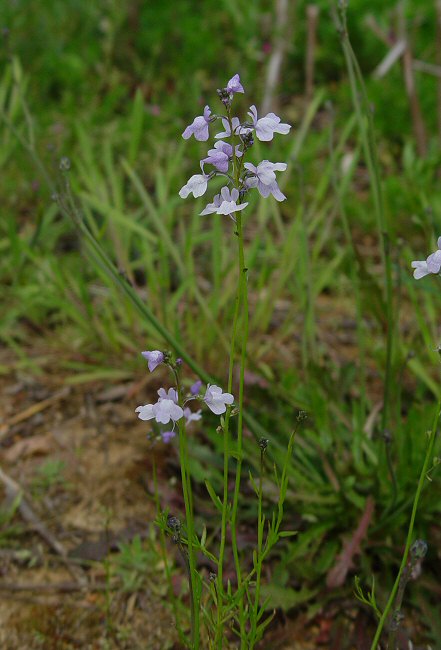Nuttallanthus texanus (Scheele) D.A. Sutton
Southern Blue Toadflax

Native
CC = 3
CW = 5
MOC = 33
© DETenaglia
Nuttallanthus texanus (Scheele) D.A. SuttonSouthern Blue Toadflax | |
 |
Native CC = 3 CW = 5 MOC = 33 |
© DETenaglia |
|
Family - Plantaginaceae Habit - Taprooted annual forb. Stems - Vegetative stems mostly prostrate, in a rosette, to 6 cm long. Flowering stems erect, to 40 cm, single or multiple from base, unbranched or with ascending branches toward the tip, glabrous, sometimes sparsely glandular-hairy in the inflorescence.
Leaves - Leaves of flowering stems alternate, simple, entire, linear, sessile, 0.5-3.0 cm long, 0.5-2.0 mm wide, linear or threadlike, glabrous. Margins slightly thickened. Leaves of vegetative stems mostly opposite or in whorls of 3. Inflorescences - Compact terminal racemes, elongating in fruit to 20 cm, the flower stalks 1-6(-9) mm long at flowering, not becoming elongated at fruiting, each subtended by a linear to lanceolate bract. Axis glabrous to sparsely glandular-pubescent. Flower stalks 2-6 mm long, strongly ascending. Bracts 2-3 mm long, linear, bluntly pointed at the tip.
Flowers - Perfect. Calyces 2-4 mm long, deeply 5-lobed nearly to the base, the lobes slightly unequal in length, lanceolate or elliptic-lanceolate, sharply pointed at the tip, glabrous. Corollas 13-22 mm long (including the spur), bilabiate, 5-lobed, glabrous or sparsely hairy toward the base of the lower lip, the tube shorter than to about as long as the lobes, pale blue to light purplish blue, sometimes with a paler or white throat, the tube with a curved, slender spur 6-11 mm long at the base (this positioned between the lower 2 calyx lobes), the throat partially closed by the strongly convex base of the lower lip, the upper lip relatively short, more or less straight, flat, the lobes erect or angled slightly backward, the lower lip with the lobes spreading and somewhat curved. Fertile stamens 4, the filaments of 2 lengths, not exserted, somewhat curved inward toward their tips, the anther sacs spreading; staminodes absent. Style 1, not exserted, the stigma capitate, unlobed.
Fruits - Capsules 2.0-3.5 mm long, oblong-ovoid to broadly oblong-ovoid, glabrous, the 2 locules equal in size, each dehiscent from the tip by 3-5 teeth. Seeds numerous, minute, 0.4-0.5 mm long, bluntly angled, lacking ridges, the faces with dense, small, relatively prominent tubercles.
Flowering - May - November. Habitat - Glades, ledges and tops of bluffs, upland prairies, sand prairies, dry upland forests, savannas, pond margins, pastures, railroads, roadsides, and open, disturbed areas; often on sandy or acidic substrates. Origin - Native to the U.S. Other info. - This attractive little species can be found predominantly in the southwestern or southeastern parts of Missouri. It also occurs somewhat sporadically throughout much of the continental U.S. except for northeastern regions. It is easily identified by its slender, willowy appearance and irregular blue flowers which have a long (6-11 mm), curved basal spur. The spur of the corolla is longer than the calyx, and filled with nectar to attract pollinating insects. Another species, N. canadensis (L.) D.A. Sutton, is similar but has smaller flowers with a spur only 2-6 mm long. This latter species is found in many of the same areas of the state, and the two sometimes grow in mixed populations. Some botanists have treated them as the same species. Photographs taken at Tuskeegee National Forest, AL., 3-26-05 (DETenaglia); also at Holly Ridge Conservation Area, Stoddard County, MO, 5-5-2011, LaBarque Creek Conservation Area, Jefferson County, MO, 5-9-2017, and Sand Prairie Conservation Area, Scott County, MO, 5-6-2020 (SRTurner). |